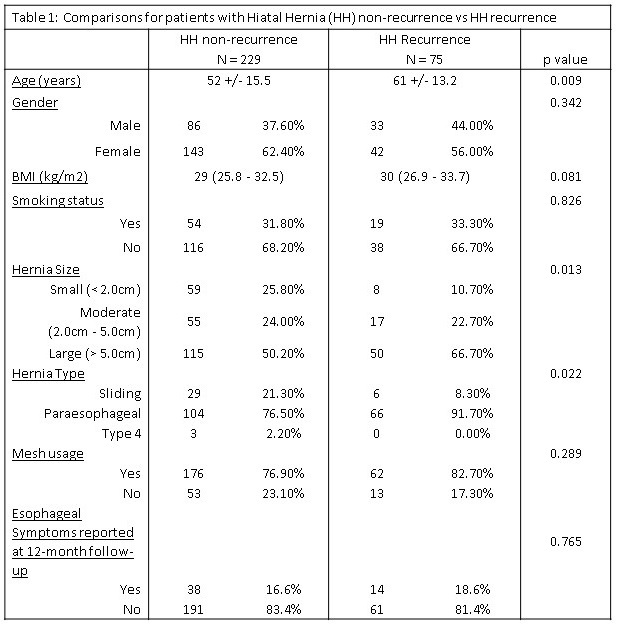|
Back to 2017 Posters
PREDICTORS OF HIATAL HERNIA RECURRENCE AFTER LAPAROSCOPIC ANTI-REFLUX SURGERY WITH HIATAL HERNIA REPAIR: A PROSPECTIVELY COLLECTED DATABASE ANALYSIS
Priscila R. Armijo, Spyridon Pagkratis, Dmitry Oleynikov*
University of Nebraska Medical Center, Omaha, NE
Introduction
The rate of radiographic hiatal hernia (HH) recurrence after anti-reflux surgery has been reported to be from 15% to 60%. While many recurrences are only radiographic with patients remaining asymptomatic, factors that can predict recurrence are not well understood. The aim of this study is to identify those factors that can predict HH recurrence in patients after anti-reflux surgery with HH repair.
Methods
A single-institution, prospectively-collected database was reviewed for patients with diagnosis of GERD who underwent laparoscopic anti-reflux surgery with HH repair between January 2002 and October 2015. Demographics and esophageal symptoms scores were collected. Likewise, mesh usage, HH type (sliding, paraesophageal or type IV) and size (small, moderate and large) were evaluated. Hernia recurrence was assessed post operatively with upper GI contrast study (UGI). Comparison was done for patients who had HH recurrence (HHR) versus those who did not (NHHR). Statistical analysis was performed using IBM SPSS v.23.0.0, with α=0.05.
Results
A total of 691 patients underwent anti-reflux surgery in this period with 304 who had HH repair and returned for UGI. Mean age was 56 ± 14.3 years, 39% male and 61% female, and mean follow-up of time was 20 ± 23.9 months. All 304 patients had laparoscopic approach, 90.8% had a total fundoplication and 9.2% underwent a partial fundoplication. Overall HH recurrence rate was 24.7%. Patients who had HH recurrence were significantly older and had larger HH compared to the NHHR group (Table 1). Similarly, HHR patients had higher rates of paraesophageal hernias at the time of the anti-reflux surgery than NHHR patients. There was no significant difference between the groups for the variables of gender, BMI, race, and mesh usage. Among all patients with HH recurrence, only 14 patients (18.6%) reported mild to moderate heartburn, regurgitation, solid or liquid dysphagia at follow-up. Reoperation rate was 3% in this patient population.
Conclusion
Hiatal hernia recurrence was correlated with larger hernias at time of surgery and advanced patient age. Use of mesh and patient BMI were not predictive of either recurrence or symptomatic failures. Furthermore, no correlation was identified between hiatal hernia recurrence and presence of gastroesophageal reflux symptoms. Hiatal hernia recurrence after repair is relatively common but appears to be asymptomatic in the majority of cases. Reoperation is rare as most patients do not develop symptoms. Mesh is not routinely needed and very large paraesophageal hernias in the elderly will commonly develop asymptomatic radiographic recurrences that do not require intervention.

Back to 2017 Posters
|


